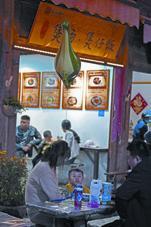Doorway to Life
2019-11-05

Doorway to Life
Members of China International Search and Rescue Team clear a rescue passage at a simulated earthquake scene at a training base in Beijing on October 21.
The team, as well as China Search and Rescue Team, passed UN assessments on October 23, making China the fi rst Asian country with two heavy urban search and rescue teams certifi ed by the world body.
Hybrid Rice
The third-generation hybrid rice developed by Yuan Longping, the“father of hybrid rice,” and his team underwent its fi rst public yield monitoring on October 21-22, achieving a high output.
The fi nal yield of the tested variety, G3-1S/P19, came to 1,046.3 kg per mu (nearly 600 square meters), from two plots in Qingzhu, a village in central Chinas Hunan Province.
Unlike the previous two generations that required more water and fertilizers as well as technological support, the new variety is easier for ordinary farmers to grow.
At present, Chinas average yield of rice is about 500 kg per mu. Ordinary farmers can produce 600 kg to 700 kg from the same area by growing some excellent secondgeneration hybrid rice varieties, according to Li Xinqi, a researcher with the Hunan Hybrid Rice Research Center.
“However, under the same planting conditions and environment, the yield of the third-generation hybrid rice could reach 800 kg,” Li said.
China now feeds around 20 percent of the worlds population with less than 9 percent of the worlds arable land.
Yuan, who developed the worlds fi rst hybrid rice in the 1970s, has set multiple world records in hybrid rice yields.
At present, Yuans team has nine third-generation hybrid rice combinations under trial, which are expected to achieve commercial seed production in the following three to four years.
“The third-generation hybrid rice has the comprehensive strength to promote a greener and more sustainable development of Chinas rice production with higher quality and yield,” Yuan said.
Better Ecology
The ecological environment in pilot areas of national parks has improved amid strengthened protection, Chinas forestry authority said.
Wildlife population saw steady growth in pilot national parks such as Sanjiangyuan in the northwestern province of Qinghai and Shennongjia in the central province of Hubei, as natural resources monitoring platforms were built, Tian Yongchen, an offi cial with the National Forestry and Grassland Administration, said.
Pilot projects are underway for 10 national parks, covering 220,000 square km in 12 provincial-level regions.
A series of measures for ecological governance have been taken in these areas, such as constructing ecological corridors, removing alien species and restoring bare mountains.
Community co-management has been promoted with ecological migration and local residents encouraged to participate in the protection of pilot national parks.
The government has pledged to speed up the legislative process to clarify standards for national parks and give priority to the establishment of national parks in eligible regions.
A third-party assessment will be organized for the pilot projects to realize national parks potential to support scientifi c research, education, recreation and community development.
China plans to conclude the pilot projects and offi cially set up a batch of national parks by 2020, the administration said.
Rare Diseases
The National Health Commission has launched an information system to register the treatment of rare diseases in a bid to promote their diagnosis and treatment.
More than 300 hospitals in a collaborative network are required to register the information of all patients with rare diseases from November 1 and fi nish registering those treated since 2015 by the end of the year.
With the data collected, the diagnosis and treatment service, medical care and access to medicines for rare diseases are expected to be improved, according to Zhang Shuyang, Secretary General of the China Alliance of Rare Diseases.
Misdiagnosis and diffi culties surrounding drug use are among the main challenges in diagnosing and treating rare diseases, he said.
Swarm Intelligence
China Electronics Technology Group Corp. (CETC) introduced a multifunction processing unit for swarm intelligence systems on October 22.
A swarm is a group of unmanned vehicles driven by artifi cial intelligence (AI). Swarming drones, for instance, communicate with each other while in fl ight, and can respond to changing conditions autonomously.
The processing unit, which can act like a brain for unmanned systems with AI technologies, was unveiled at the Sixth World Internet Conference in Wuzhen, east Chinas Zhejiang Province.
According to the CETC, the processing unit features fl ight control, mission planning, intelligent decision-making and dynamic networking, integrating the fl ight control system and the measurement and control system of traditional drones.
It has been installed in some drone swarms and is expected to be applied in unmanned cars, boats and robots with swarm intelligence.
Zhao Yanjie, an unmanned system expert at the CETC, said with electromagnetic, optical, acoustic and other sensors installed, the drones can monitor, search and track, holding wide application prospects in fi elds like natural disaster management, environmental protection and emergency response.
Catch ‘Em Young
A student from Zhentou Primary School learns how to fi ll a traditional Chinese medicine prescription at a community health service center in Shijiazhuang, north Chinas Hebei Province, on October 21.

Power Grids
Billions of yuan have been invested to upgrade power networks in rural areas of Xinjiang Uygur Autonomous Region in northwest China to assist anti-poverty efforts.
A total of 2.6 billion yuan($370 million) from the Central Government has been spent this year, while the regional government and the local grid power companies have also increased investment to improve power facilities, offi cial statistics showed.
Thanks to uninterrupted power supply, an embroidery cooperative in Akqi, a county in south Xinjiang, has brought in more income for village women.
Upgraded power infrastructures in east Xinjiangs Hami have enabled local melon farmers to irrigate land even under severe weather conditions.
The regional government has also invested nearly 3.4 billion yuan($480 million) this year to channel fresh tap water to over 266,000 poor residents. Nearly 2,500 km of rural roads have been built to enhance connectivity.
Seeing Is Believing
A group of foreign students visit the Institute of Advanced Technology at the University of Science and Technology of China in Hefei, east Chinas Anhui Province, on October 18, during a trip to learn about the latest scientifi c and technological development in China.

Sped-Up Lives
More than 76 percent of Chinese young people think they are living a sped-up life, according to a survey released by China Youth Daily.
Young people surveyed in fi rst- and second-tier cities widely consider they live a faster lifestyle, with 78.9 percent and 77.6 percent, respectively.
Accelerated lives are very common among young people at home and abroad, which show their hunger for success, according to Xu Guangxing, a psychology professor at East China Normal University in Shanghai.
However, 83.1 percent of the interviewees fi nd that although they are busy every day, they do not have the sense of fulfi llment they expected.
The advent of the information age and higher self-expectations are regarded as two major reasons why young people live a fast-paced life, according to the survey, which covered 1,993 people aged between 18 and 35.
WTO Offer
China has submitted the seventh offer to join the World Trade Organizations Agreement on Government Procurement (GPA), which added the military sector for the fi rst time, according to the Ministry of Finance.
The revised offer also added seven provinces, 16 state-owned enterprises and 36 local universities.
The offer was a major move to speed up the negotiation process of joining the GPA, fully demonstrating Chinas determination in opening wider to the outside world and safeguarding the multilateral trading system, the ministry said.
The GPA, a multilateral treaty, requires its members to open up their domestic government procurement markets, as it aims to expand international trade.
China started the GPA entry negotiation process in 2007, which focuses on opening up areas as well as the adjustment of relevant domestic laws.
Banking on Natural Gas
Workers conduct a routine inspection at a gas storage station in Puyang, central Chinas Henan Province, on October 17. The facility is a major project during the 13th Five-Year Plan (2016-20) period, with its total capacity expected to reach 10.4 billion cubic meters.

ChiNext Decennial
As of October 21, the number of listed companies on ChiNext, Chinas Nasdaq-style board, reached 774, with a total market capitalization of 5.59 trillion yuan ($790.66 billion), data from the Shenzhen Stock Exchange showed.
ChiNext, also known as the Growth Enterprises Market, was inaugurated in Shenzhen on October 23, 2009.
Tailor-made for the needs of fi rms engaged in innovation, ChiNext has fostered several new economic industry leaders, such as battery producer CATL and medical devices and solutions provider Mindray.
A group of innovative enterprises have raised funds through ChiNext and their exemplary and spillover effects have led to the creation of a national support system for small and medium-sized enterprises, according to a statement of the Shenzhen Stock Exchange.

Green Energy Developer
In 2018, China topped the world in terms of newly-added and cumulative installed photovoltaic and wind power capacities, said a report, released at a green energy development conference in Yangzhong, east Chinas Jiangsu Province, on October 15-16.
The country is also leading the world in investments in renewable energy, the report noted.
Boasting multiple green energy patents, China is among the worlds most capable powers in developing renewable energy.
Yangzhong has been listed as a model city in renewable energy applications by the National Energy Administration, epitomizing the countrys efforts to build a green society.
While Chinas green energy policies and industrial systems are gradually improving, development in the sector still faces some bottlenecks, including fi nancing diffi culties for businesses and rising operational costs.
To address such issues, the report suggested strengthening policy guidance to encourage business innovation and create more fi nancing channels for them.
Chinas energy sector is accelerating its transition to a clean low-carbon mode. Renewable and nuclear energy have accounted for more than half of Chinas annual increase in installed capacity since 2013, according to a report by the International Energy Agency.
Commercial Rockets
China Rocket Co. Ltd. released its research and development plan for commercial carrier rockets in Beijing on October 19.
The companys solid- and liquid-propellant carrier rockets will satisfy the improving commercial payload in-orbit demand, said its President Tang Yagang.
The solid-propellant carrier rockets of the Smart Dragon (SD) series, SD-2 and SD-3, are expected to conduct fl ight tests in 2020 and 2021, respectively.
The SD-2, with a total length of 21 meters, a diameter of 2 meters and a total weight of about 60 tons, will be capable of sending 500-kg payloads to the solar synchronous orbit at an altitude of 500 km.
The SD-3, with a total length of 31 meters, a diameter of 2.6 meters and a total weight of about 116 tons, will be capable of sending 1.5-ton payloads to the solar synchronous orbit at an altitude of 500 km.
Meanwhile, SD-1 made its maiden fl ight in August.
The SD series is designed to provide reliable, convenient and economical launching services for commercial satellite users in the constellation network and payload tests, according to Tang.
The medium-sized liquidpropellant carrier rocket will be reusable for the launching of large and medium-sized satellites and large-scale constellation network. It is also expected to make its fi rst fl ight test in 2021, the president added.
Nighttime Tourism
Tourists have dinner at a restaurant in a scenic spot in Yuncheng, north Chinas Shanxi Province, on October 19. Once a rock patch with wild weeds running riot, the area has been developed into a rural tourism resort.

Vaccine Plan
The vaccine industry will be reorganized to promote the growth of larger vaccine makers, an offi cial said on October 15.
Authorities will seek a higher level of industry concentration and spur the growth of viable companies, with measures like raising the bar for market access and bettering the bidding process, said Wang Jiangping, Vice Minister of Industry and Information Technology, at the inauguration of the China Association for Vaccines (CAV).
The CAV is expected to provide business counseling and technology services for vaccine companies nationwide, as well as respond to public inquiries, according to Wang.
The annual output of Chinas vaccine industry is 25 billion yuan($3.5 billion). Among the 45 vaccine companies currently in operation, only 38 are in production, while 20 produce only one type of vaccine annually.
